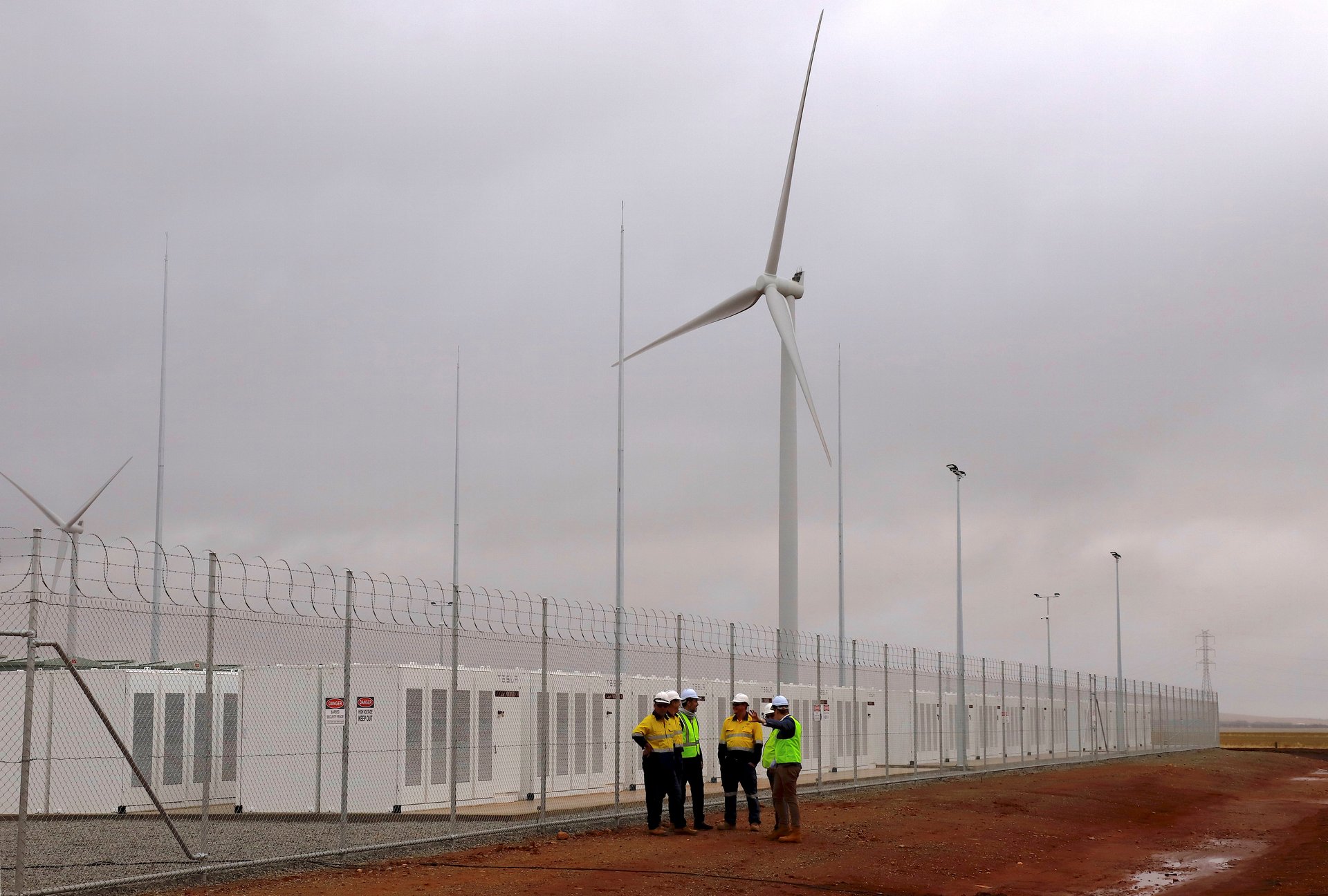Tesla just officially turned on one of the world’s largest batteries
What started as a bet on Twitter by Tesla CEO Elon Musk is now a massive battery storing and dispatching power for South Australia.


What started as a bet on Twitter by Tesla CEO Elon Musk is now a massive battery storing and dispatching power for South Australia.
After blackouts darkened the entire region in 2016, the government needed a fix. Past solutions, such as natural gas “peaker” plants that spin up during periods of high demand, can take years and hundreds of millions of dollars to build. Lithium-ion batteries, now at the price and scale to back up entire power grids, were an obvious answer. In March, Musk offered a money-back guarantee on Twitter that Tesla could get a 100 megawatts of power capacity up and running within 100 days.
And so, nearly nine months later, it was ready. Today (Dec. 1) the Hornsdale Power Reserve battery system, connected to a nearby wind farm run, was officially turned on for the first time (it started supplying power yesterday, as hot weather increased demand). The battery array holds enough energy to supply more than 30,000 homes for about an hour in an emergency, and supply electricity during other periods.
This is just the latest in a string of project by Tesla and others around the world deploying massive grid-scale batteries. Altagas, AES and Tesla deployed huge battery storage projects in Southern California this year in the wake of 2015 natural gas leak. Tesla built an emergency solar and battery system in Puerto Rico after a hurricane knocked out power to much of the island this year. Hawaii, New Zealand, UK and Pacific islands have all seen new systems come on line as well.
Despite these achievements, battery makers face a feast or famine challenge in the utility storage market. With residential and commercial business small (but growing), quarterly revenues from battery storage markets gyrate along with the calls to patch holes in ailing grids, reports Greentech Media. That makes it hard to build a business. ”You cannot have a business model that’s just waiting for these events to occur so you can jump in and be a savior,” said Ravi Manghani, energy storage director at GTM Research.
What’s needed is a change in mindset and a change in markets. First, utility operators are still warming up to the idea (and price tag) of adding batteries to their electrical grids. Before now, batteries were only seen as a solution in extreme circumstances. That’s not the case anymore, John Zahurancik, AES’s president of battery storage, told Bloomberg. “This is my fifth time doing the largest project in the world for energy storage, and each time people tell me, ‘Well this is the test, this is really the test,’” he said in January. “The next big test is how do we scale this up broadly.”
Price stands in the way. The economics of fossil-fuel peaker plants still edge out batteries in some cases. But that won’t last, as prices for renewable energy and battery storage continue their free-fall: lithium-ion batteries are just about half their price in 2014. The duo is expected to be cost competitive by 2025 by providing back-up power and services such as balancing the amount of electricity on electrical grids.
Designing markets that pay for such services is another factor. The US, and other countries, have a mix of regulated electric markets (Texas, South Australia), and deregulated ones (California and others) where wholesale energy providers can bid on the supply of the cheapest, most reliable energy. Once more regulators embrace battery integration, allowing them to compete equally with legacy fuels, the economics of renewables plus storage should grow even more attractive. Already, more than 95% of new energy-storage deployments in 2015 were lithium-ion technologies.
Tesla, LG Chem, Panasonic (a Tesla partner), Mitsubishi, Samsung and many, many others are now positioning themselves to be the next generation of suppliers. Tesla is proving to be one of the biggest risk-takers by staking out huge projects like the one in Australia, and building out a massive internal demand for its own batteries through Tesla vehicles.
Tesla, which dropped the word “motors” from its name earlier this year, told investors in May that its energy storage business is already scaling “several times” faster than its car line. The company expects to produce 15 gigawatt hours of battery storage a year in the 2020s. ”We are an energy innovation company as much as a car company,” said Tesla CTO JB Straubel.